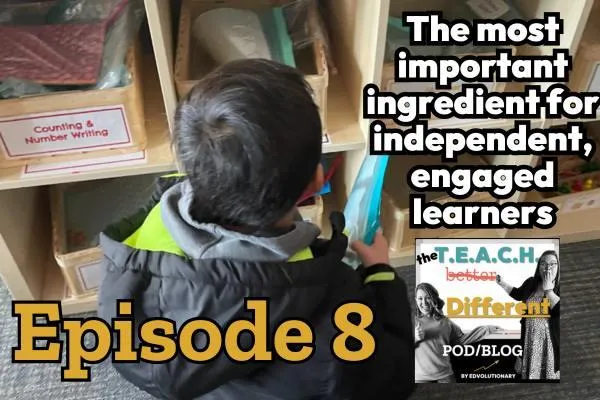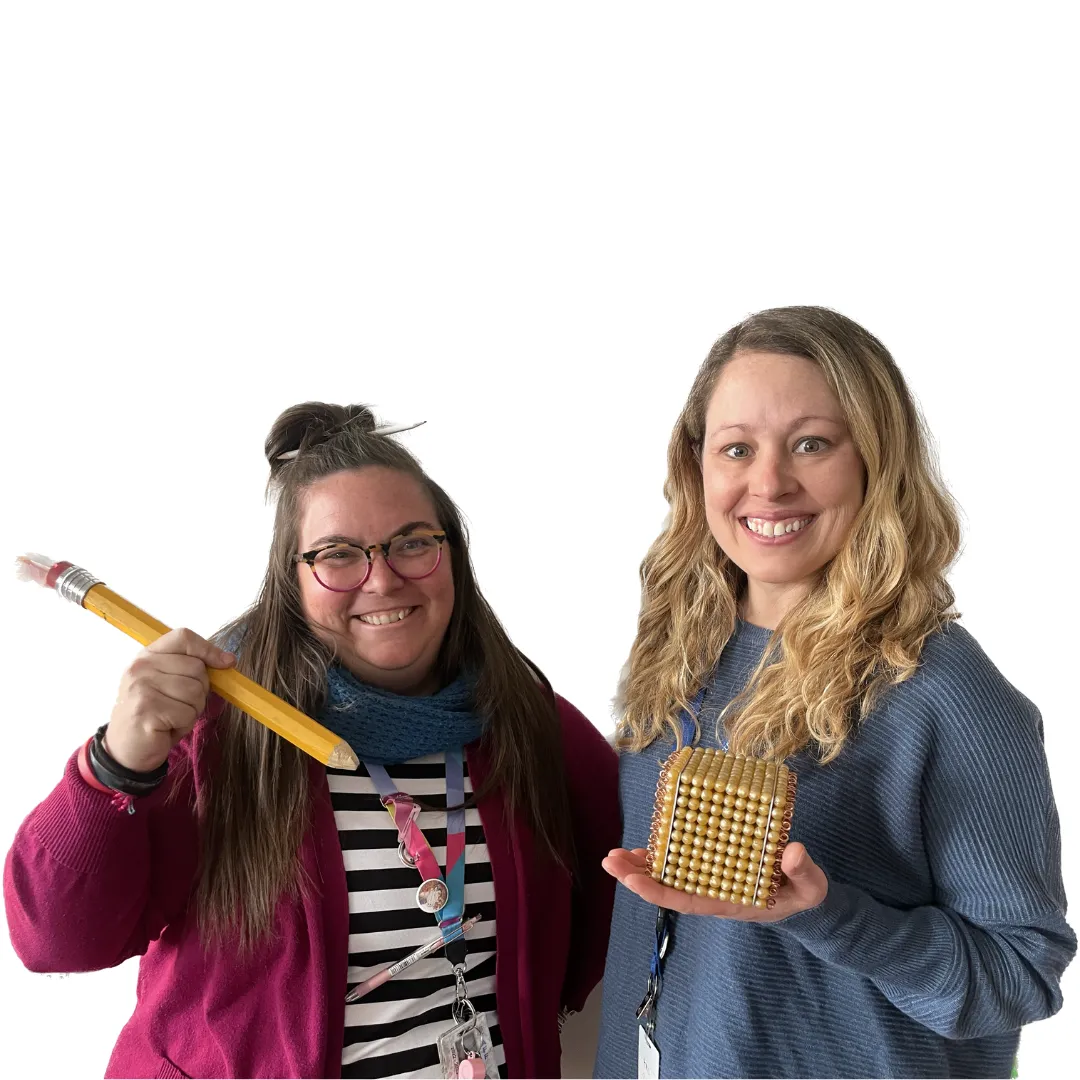The TEACH Different (not better) POD/BLOG
CREATE THE CONDITIONS THAT UNLOCK STUDENT ENGAGEMENT, ACHIEVEMENT, & WELLBEING

8. The most important ingredient for independent, engaged learners
Listen to the episode:
This week's post is brought to you by the letter H in our T.E.A.C.H. Framework! Learn more about the Framework here.
Request this week's companion resource in the form at the bottom of this post under "Time for Action."
Get notified about our TEACH Different Community!
Post/Episode Summary:
Want actionable ideas on how to create the conditions that bring out the best in your students?
This week we start a 3-part series that gives you all the details! If you’re just tuning in you can get an overview of what I’m talking about by catching up on episode 6 and 7!
What outcome do you want?
Management (noun): The process of dealing with or controlling things or people.
Autonomy (noun): self-governing; ability of a person or group to choose a course of action.
I have a question for you. Which would you pick out of these two idealized situations?
1. a classroom where your students were all easy to manage and did exactly what you said OR
2. a classroom where students largely governed themselves and their learning and you were able to be responsive to giving the lessons and support students needed as they needed it?
Another question….same choices.
Which situation is likely to set students up for more life success? Being able to do what others say without being a jerk about it, or being able to determine what you need to do to be successful in any given situation?
These might be obvious questions for anyone in this particular audience to answer… buuuuuuuut… consider what kind of professional development teachers typically receive. Guidance on how to be leaders who successfully unlock the ability for self-government in others? Or better classroom managers?
Last week we talked about a new paradigm or map that can help us create the conditions where people are naturally motivated, productive and happy and require less management from us. There are three psychological needs you need to meet in order to do this, and the foundational one, according to the researchers who first defined this theory, is autonomy.
Like I said a moment ago… and I realize I’m generalizing here…but our professional development as teachers rarely talks about or gives us the tools to productively foster autonomy in students. Those who attempt on their own often end up in chaos and give up (see exhibit A,you can’t see me but I’m pointing myself… minus the giving up part).
So let’s try to change that.
The power of autonomy
Autonomy: self-governing; ability of a person or group to choose a course of action.
Here are a few more questions for you:
1. How often has professional development you’ve been a part of talked about how you can foster autonomy in students?
2. How often in the school day do your students have the opportunity to make meaningful decisions about what they do, how they do it, or what happens to them in general?
I’m guessing if you’re experience in schools has been anything like mine… and I’ve been in some schools I would consider good as well as some that were not so good… there weren’t many examples you could conjure up for either question.
This is a problem for three reasons:
1.We obviously can’t create enviornments that unlock the best in our students without this critical ingredient.
2. Our learners become dependent when they have no opportunity to make decisions. AND
3. A big one: Many of the leading child psychologists today think that children’s low sense of control in their lives (aka lack of a autonomy) is a HUGE part of what is to blame for the increasing mental health crisis in young people. And these mental health issues are fueling the increased behavior challenges in our classrooms.
One of my favorite quotes about this last problem I share all the time is from the book The Self-Driven Child. The authors Dr. William Stixrud and Ned Johnson write:
“A low sense of control (aka lack of autonomy) may very well be the most stressful thing in the universe. Over the last sixty years, study after study has found that a healthy sense of control (aka feeling of autonomy) goes hand in hand with virtually all the positive outcomes we want for our children. Perceived control– the confidence that we can direct the course of our life through our own efforts–is associated with better physical health, less use of drugs and alcohol, and greater longevity, as well as with lower stress, positive emotional well-being, greater internal motivation and ability to control one’s behavior, improved academic performance, and enhanced career success. Like exercise and sleep, it appears to be good for virtually everything, presumably because it represents a deep human need.”
All of those positive things listed were the result of a higher-locus of control; aka, a feeling of autonomy.
So motivated, productive and happy students are going to probably continue to be a myth in our classrooms until we can figure out how to productively meet this deep psychological need for autonomy.
Challenges
That is easier said than done in my experience and possibly yours.
In order to be successful at this, we can’t fall into the trap of black and white thinking and the notion that autonomy is all or nothing.
Just like in most adults’ lives, there is a balance of things you have decision-making power over, and things you just have to do. When autonomy is out of balance in either direction you can have pretty negative consequences. Too little autonomy and you have strained mental health that leads to either disengagement or lashing out. Too much and you get overwhelmed and feel unsupported…and this can also cause behavior issues in our students.
We also have to meet people where they are- not where we would like them to be. Students who are used to being “managed” are likely to devolve into chaos without the scaffolded support to build their capacity for autonomy.
We want to avoid all the negative outcomes I just mentioned, and so the ideas that make up the rest of the episode are going to be delivered in order of how easy they are to start implementing right away.
I’m working on a mini-ebook to accompany this 3 week series on autonomy, mastery and relatedness that will contain all the ideas in these episodes with pictures so if you’re interested in me sending that to you when it’s done (roughly around the end of July) there’s a link in the Time for Action section at the bottom of this post.
5 ideas to foster autonomy in your classroom
1. Notice your language
I once heard Letty Rising, a Montessori elementary trainer talk about the power of our adult language. She said that whenever we speak, it can be classified in one of these five ways:
Positive statements: “I enjoy the colors you chose for your painting!”
Negative statements: “Stop acting like a baby.”
Neutral statements: “I see that you chose a math activity.”
Directives:“Please put your dish in the sink.”
Questions: “What do we do before we have lunch?”
Classrooms that function really well have a mixture of positive statements, neutral statements, and questions.
Research was done in several classrooms to see what percentages of these types of statements were most common. Can you guess? It was directives. And directives create lots of opportunities for students to feel “bossed around” aka not in control… and want to resist.
Rising suggests that we teachers practice framing directives in the form of a question to put the thinking on the student and make them feel like they are in control. For example, “Okay it’s 12! What do we do at 12?”
In a similar vein, Michaeleen Doucleff, author of Hunt, Gather, Parent, gives the advice to turn directives into a form of neutral statement called a “consequence puzzle.” For example, if a student is throwing wood chips up in the air around a bunch of other kids on the playground and I want him to stop before it causes a problem, instead of saying, “stop throwing wood chips,” I would say, “Those could get in someone’s eyes.” It’s called a consequence puzzle because children don’t always see ahead the consequences of their actions. This identifies it for them, but then puts processing of that information and ultimate decision making on what to do about it on them.
Both of these suggestions on language put students in the more empowered position of feeling like they are being trusted to figure something out or make a decision, and that fosters their feelings of autonomy.
Language is so powerful isn’t it? So is the absence of language which brings me to number 2.
2. Minimize teacher voice throughout the day
Instead of repeating the same directions for every block every day… assess which routines students will repeat and create slides or posters that provide visual reminders of what to do. We literally take pictures of students doing the routine, or holding the material they need to bring to the carpet and display them… and then practice with students so they know where to look to find out what to do if they forget.
Musical transition songs are also incredible because when practiced over and over they create auto-pilot-like responses in students to carry out the routine they represent. It’s a little pavlovian but also… takes the teacher out of actively managing and students perceive that they are managing themselves.
Another way we can limit teacher voice is to bake limits into the environment. Here’s an example: One activity my students used to love in math was making number scrolls to 1000. When given the choice, many would spend days on the activity and then still want to do it again. Instead of telling them that they had to do other things… I just started putting fewer blank number grids on the activity shelf, and kids had to do other activities. And I wasn’t the bad guy that stopped their fun… the pesky activity shelf was.
3. Provide choices in seating
If students are in a content time where there is little other choice, then choice of seating is a great way to inject some autonomy. This is a simple one you may already be doing but it requires you teach students when it’s appropriate to use a particular seat, and make sure you uphold expectations with using that seat. Here are the choices we provide and the norms for each:
Tables- can sit at any time
Work mats ( yoga mats)- for games or activities that don’t involve writing. No more than 3 people at a work mat.
Chowkis (tv trays)- a one-person work space. Choose one when you want to be by yourself, away from others. A good place for writing.
If students aren’t meeting the expectations for a type of seating, you can start with a question: “What are the norms for chowkis?” One person… great. One of you will need ot find an alternative or we’ll have to just put the chowki away.”
And if they don’t change it: “It looks like we aren’t using the chowki the way we’ve agreed to in this classroom. You can try again tomorrow if you would like. For now, you need to put it away and choose another place to work.” These things should be said neutrally, without any emotion or judgement and no negotiations allowed.
4. Create self-directed centers
Centers are an incredible opportunity to give kids autonomy. But many teachers avoid them because of the management challenges or material challenges OR when they do do them, students often move through them in a fixed rotation where every student goes to every center. Whenever I have done fixed rotations, there are a few problems.
Not every kid needs to do the activity in every center. Boredom= behavior challenges.
Because students didn’t make the choice of what they are doing, I often have to play whack-a-mole to manage them to use materials correctly, making small groups impossible. More behavior challenges.
By providing choice, we can get some amazing benefits in authentic student engagement. I could do a whole episode on this and in fact did create a whole audioguide on the details and benefits of self-directed student centers which we call “mastery-based choice” so if you want more info you can find the link to request this awesome audioguide in the shownotes.
5. Plan for autonomy throughout your day
As I said in previous episodes and at the beginning of this episode, autonomy is not all or nothing. But you are going to have exponentially more benefits if you weave it throughout your day than if you have it in just one part of your day. Here are some places we’ve woven autonomy throughout our day throughout our years of teaching:
Morning soft start- students trickle into the classroom. They have a choice of eating breakfast and/ or making an activity choice before the morning meeting begins.
Literacy self-directed centers- while annie teaches in small groups, the other students can make choices of their centers activities.
Lunch/Recess- self-explanatory
Quiet time: I actually forgot about this until drafting this episode, but the Responsive Classroom has a protocol called “Quiet time”. It’s basically a time that happens after the chaos of lunch and recess. Students come in and for 10-15 minutes they can go to the bathroom, get water, or make a quiet activity choice like reading, writing, drawing… I used to LOVE it.
Math self-directed centers (similar to above)
Choice when students finish work (when I’m done journals, centers activities)
Time for Action
Request the ebook for this series!
Request the audio guide on self-directed centers (we call Mastery-Based Choice)
Also…If you want to join a community further diving into these topics and others of our TEACH Framework, don’t forget to sign up to be notified when our TEACH Different Collective opens later this year! To read about our initial vision, give your input and/or join the list to get notified when this community opens, go to edvolutionary.com/collective. You can also add your name to the notification list using the form below!
All links from this post/episode
Drive: The Surprising Truth About What Motivates Us by Daniel Pink
The Self-Driven Child Us by Dr. William Stixrud & Ned Johnson
Thank you for being on the journey with us as we build out this content
What do we mean by TEACH Different (not better?)


